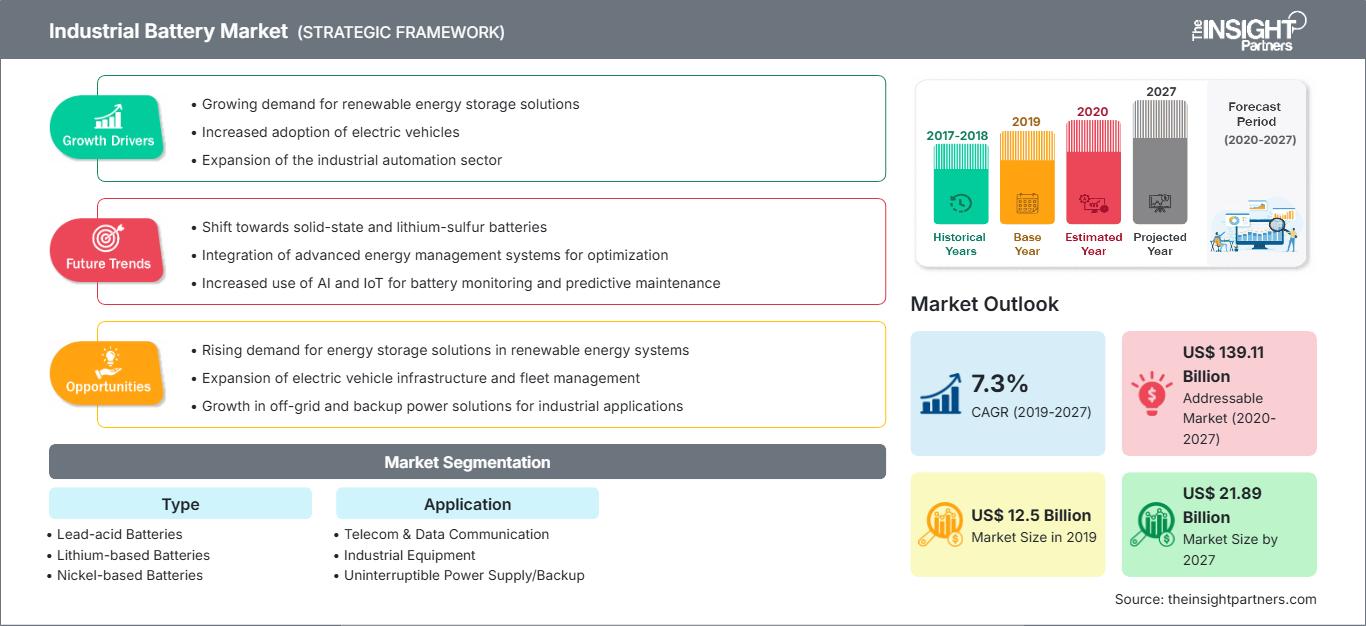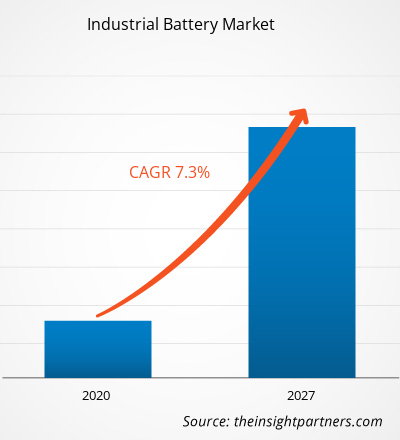Der Markt für Industriebatterien wurde im Jahr 2019 auf 12.501,9 Millionen US-Dollar geschätzt und soll von 2020 bis 2027 mit einer durchschnittlichen jährlichen Wachstumsrate von 7,3 % wachsen und bis 2027 21.893,5 Millionen US-Dollar erreichen.
Industriebatterien sind speziell entwickelte Batterien, die unter harten Industrietemperaturen wie extremen Temperaturen, stärkeren Vibrationen und starker Beanspruchung betrieben werden können. Industriebatterien sind leistungsfähiger und auf höhere Leistung ausgelegt. Im aktuellen Marktszenario arbeiten die Unternehmen konsequent an der Entwicklung hocheffizienter Batterien, die den unterschiedlichen Anforderungen an Industriebatterien gerecht werden. Der globale Markt für Industriebatterien wird im Prognosezeitraum voraussichtlich ein beeindruckendes Wachstum verzeichnen. Die Nachfrage nach Lithium-basierten Batterien wird im Prognosezeitraum voraussichtlich deutlich steigen. Die Verwendung von Lithium-Batterien wird aufgrund ihrer Vorteile wie geringer Emissionen, längerer Lebensdauer und Recyclingfähigkeit voraussichtlich in verschiedenen Branchen zunehmen. Die am Markt tätigen Unternehmen konzentrieren sich auf die Entwicklung neuer Produkte, um eine starke Kundenbasis aufzubauen und einen signifikanten Marktanteil zu erreichen.
Die Regierungen nordamerikanischer Länder, wie beispielsweise der USA, unternehmen kontinuierlich Schritte, um die Produktivität der Fertigungsindustrie zu steigern. Dazu gehören die Bereitstellung neuester Technologien zur Vereinfachung von Fertigungsprozessen und die Erhöhung der Anzahl von Lagerhallen. Der Einsatz automatisierter Technologien in diesen Lagerhallen dürfte das Wachstum des Industriebatteriemarktes in Nordamerika beeinflussen. Die erhöhten staatlichen Ausgaben fördern die Entwicklung neuer Technologien. In Nordamerika sind die staatlichen Ausgaben für technologischen Fortschritt recht hoch, was ein günstiges Klima für die Entwicklung jedes Unternehmens schafft. IoT, Big Data und fortschrittliche Technologien erfreuen sich in dieser Region einer hohen Akzeptanz. Diese Technologien wiederum fördern den Bedarf an erweiterten Netzwerken und die Nachfrage nach Industriebatterien. Zu den aufstrebenden Technologien im Industriebatteriemarkt gehören Lithium-Ionen-Batterien (Li-Ionen), Lithium-Schwefel-Batterien, Festkörperbatterien, Aluminium-Ionen-Batterien usw. der neuen Generation.
Passen Sie diesen Bericht Ihren Anforderungen an
Sie erhalten kostenlos Anpassungen an jedem Bericht, einschließlich Teilen dieses Berichts oder einer Analyse auf Länderebene, eines Excel-Datenpakets sowie tolle Angebote und Rabatte für Start-ups und Universitäten.
Markt für Industriebatterien: Strategische Einblicke

-
Holen Sie sich die wichtigsten Markttrends aus diesem Bericht.Dieses KOSTENLOSE Beispiel umfasst Datenanalysen, die von Markttrends bis hin zu Schätzungen und Prognosen reichen.
Die wichtigsten erneuerbaren Energiequellen sind Sonne und Wind, die im Netz gespeichert werden. Bewölkung oder Schwankungen der Windströmung können jedoch zu Schwankungen im Energieerzeugungsprozess führen. Solche Veränderungen erfordern flexible Netzsysteme zur Energiespeicherung. Industrielle Batteriespeichersysteme helfen Netzbetreibern, Strom zu sparen, wenn die Strommenge den Strombedarf übersteigt. Der zunehmende Einsatz dieser Systeme trägt somit zur Verbesserung der Zuverlässigkeit und Flexibilität des Stromversorgungssystems in Bezug auf Erzeugung, Übertragung und Verteilung bei. Während der Übertragung und Verteilung übernehmen Batteriespeichersysteme verschiedene Aufgaben wie Anlagenverzögerung, Oberschwingungsunterdrückung, Spannungsstützung, Frequenzregelung und Stromqualität. Weitere Vorteile von Batteriespeichersystemen für netzgekoppelte Lösungen sind die zeitliche Verschiebung von Strom und erneuerbarer Energie, Grundlastausgleich, Spitzenlastkappung und die Festigung der Kapazität erneuerbarer Energien. Diese Vorteile fördern die Verbreitung dieser Systeme und beflügeln das Wachstum des Industriebatteriemarktes. Die Marktteilnehmer entwickeln neue Netzlösungen, um ihre Wettbewerbsfähigkeit auf dem Markt für Industriebatterien zu wahren. Siemens bietet beispielsweise SIESTORAGE an, eine intelligente Netzlösung. SIESTORAGE bewältigt die Herausforderungen der drei Hauptaspekte der Stromversorgung: Optimierung der Netzanschlüsse, Bereitstellung elastischer Energie für moderne Netze und Versorgung großer Energieverbraucher. Im Juli 2015 unterbreitete EDP Distribuicao Siemens SIESTORAGE in Évora (Portugal) zudem einen Storage InovGrid-Auftrag. Das SIESTORAGE-System bietet Dienste wie Spannungsregelung, Energie-Backup und Spitzenlastkappung für die Netzstabilität von EDP und repliziert die Vorteile intelligenter Netze für die Netzbetreiber.
Einblicke in Typen
Im Typensegment haben Blei-Säure-Batterien den größten Anteil am globalen Markt für Industriebatterien. Blei-Säure-Batterien sind kostengünstig und leistungsstark, lassen sich leicht recyceln und sind einfach aufzuladen. Blei-Säure-Batterien werden aufgrund ihrer geringen Kosten und langen Lebensdauer häufig eingesetzt. Allerdings sind sie für dauerhaft hohe Belastungen nicht geeignet. Zudem weisen sie eine relativ geringe volumetrische Energiedichte auf, was ihren Einsatz für Energiemanagementanwendungen eher ungeeignet macht. Daher werden sie hauptsächlich für Stromversorgungsanwendungen eingesetzt. Die Weiterentwicklung dieser Batterie ist noch nicht abgeschlossen, was sie zu einer praktikableren Option für das Energiemanagement machen könnte.
Anwendungseinblicke
Der Markt für Industriebatterien ist nach Anwendungen in Telekommunikation und Datenkommunikation, Industrieanlagen, unterbrechungsfreie Stromversorgung (USV)/Backup, Bergbau, Schifffahrt und andere unterteilt. Das Segment Industrieanlagen eroberte den dominierenden Anteil am globalen Markt für Industriebatterien. Die wachsenden Industrie-4.0-Trends wie IoT, Künstliche Intelligenz (KI), Big-Data-Analyse, vernetzte Kommunikation, Cloud Computing und maschinelles Lernen verändern die Arbeitsweise von Unternehmen und die Art und Weise, wie sie mit ihren Kunden interagieren, grundlegend. Diese wachsenden Technologien bieten innovative Lösungen für Industrieanlagen, die die Produktion und Lieferung effizienter Anlagen unterstützen.
Unternehmen verfolgen häufig Fusions- und Übernahmestrategien, um ihre Präsenz weltweit auszubauen und die wachsende Nachfrage zu decken. Diese Strategie ist vor allem in Nordamerika und Europa zu beobachten. Die Akteure auf dem Markt für Industriebatterien verfolgen eine Strategie der Expansion und Investitionen in Forschung und Entwicklung, um ihren Kundenstamm weltweit zu vergrößern und ihren Markennamen global zu behaupten. Einige der jüngsten Übernahmen sind unten aufgeführt:
2019: East Penn gab die Übernahme der Mehrheitsbeteiligung an Navitas Systems bekannt. Diese Übernahme soll die Erweiterung des Angebots an Motive Power Battery unterstützen. 2019: Saft gab die Übernahme von 100 % der Anteile an Go Electric Inc. bekannt, einem US-amerikanischen Entwickler von Lösungen zur verteilten Energieausfallsicherheit für Mikronetze sowie gewerbliche und industrielle Kunden.
Markt für Industriebatterien
Die Analysten von The Insight Partners haben die regionalen Trends und Faktoren, die den Markt für Industriebatterien im Prognosezeitraum beeinflussen, ausführlich erläutert. In diesem Abschnitt werden auch die Marktsegmente und die geografische Lage in Nordamerika, Europa, dem asiatisch-pazifischen Raum, dem Nahen Osten und Afrika sowie Süd- und Mittelamerika erörtert.Umfang des Marktberichts über Industriebatterien
| Berichtsattribut | Einzelheiten |
|---|---|
| Marktgröße in 2019 | US$ 12.5 Billion |
| Marktgröße nach 2027 | US$ 21.89 Billion |
| Globale CAGR (2019 - 2027) | 7.3% |
| Historische Daten | 2017-2018 |
| Prognosezeitraum | 2020-2027 |
| Abgedeckte Segmente |
By Typ
|
| Abgedeckte Regionen und Länder |
Nordamerika
|
| Marktführer und wichtige Unternehmensprofile |
|
Dichte der Akteure auf dem Markt für Industriebatterien: Verständnis ihrer Auswirkungen auf die Geschäftsdynamik
Der Markt für Industriebatterien wächst rasant. Die steigende Nachfrage der Endverbraucher ist auf Faktoren wie veränderte Verbraucherpräferenzen, technologische Fortschritte und ein stärkeres Bewusstsein für die Produktvorteile zurückzuführen. Mit der steigenden Nachfrage erweitern Unternehmen ihr Angebot, entwickeln Innovationen, um den Bedürfnissen der Verbraucher gerecht zu werden, und nutzen neue Trends, was das Marktwachstum weiter ankurbelt.
- Holen Sie sich die Markt für Industriebatterien Übersicht der wichtigsten Akteure
- Blei-Säure-Batterien
- Batterien auf Lithiumbasis
- Batterien auf Nickelbasis
- Sonstige
Markt für Industriebatterien – nach Anwendung
- Telekommunikation & Datenkommunikation
- Industrieausrüstung
- USV/Backup
- Energiespeicherung auf Netzebene
- Bergbau
- Marine
- Sonstige
Globaler Markt für Industriebatterien nach Regionen
-
Nordamerika
- USA
- Kanada
- Mexiko
-
Europa
- Frankreich
- Deutschland
- Italien
- Großbritannien
- Russland
- Übriges Europa
-
Asien-Pazifik
- China
- Indien
- Südkorea
- Japan
- Australien
- Übriges Asien Pazifik
-
Naher Osten und Afrika
- Südafrika
- Saudi-Arabien
- VAE
- Rest des Nahen Ostens und Afrikas
-
Südamerika
- Brasilien
- Argentinien
- Rest Südamerika
Firmenprofile
- C&D Technologies, Inc.
- East Penn Manufacturing Company
- EnerSys
- Exide Industries Limited
- General Electric Company
- GS Yuasa International Ltd.
- LG Chem
- Panasonic Corporation
- Robert Bosch GmbH
- Saft Groupe SA
- Historische Analyse (2 Jahre), Basisjahr, Prognose (7 Jahre) mit CAGR
- PEST- und SWOT-Analyse
- Marktgröße Wert/Volumen – Global, Regional, Land
- Branchen- und Wettbewerbslandschaft
- Excel-Datensatz
Aktuelle Berichte
Verwandte Berichte
Erfahrungsberichte
Grund zum Kauf
- Fundierte Entscheidungsfindung
- Marktdynamik verstehen
- Wettbewerbsanalyse
- Kundeneinblicke
- Marktprognosen
- Risikominimierung
- Strategische Planung
- Investitionsbegründung
- Identifizierung neuer Märkte
- Verbesserung von Marketingstrategien
- Steigerung der Betriebseffizienz
- Anpassung an regulatorische Trends






















 Kostenlose Probe anfordern für - Markt für Industriebatterien
Kostenlose Probe anfordern für - Markt für Industriebatterien